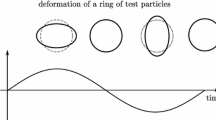Abstract
In this paper, the variation of a signal in Schwarzschild spacetime is studied and a general equation for frequency shift parameter (FSP) is presented. The FSP is found to depend on the gravitationally modified Doppler effects and the gravitational effects of observers. In addition, the time rates of a transmitter and receiver may differ. When the FSP is a function of the receiver time, the FSP contributed through the gravitational effect (GFSP) or the gravitationally modified Doppler effect (GMDFSP) may convert a bandlimited signal into a non-bandlimited signal. Using the general equation, the FSP as a function of receiver time is calculated in three scenarios: (a) a spaceship leaving a star at constant velocity communicating with a transmitter at a fixed position; (b) a spaceship moving around a star with different conic trajectories communicating with a transmitter at a fixed position; and (c) a signal transmitted from a fixed position in a star system to a receiver following an elliptic trajectory in another star system. The studied stars are a Sun-like star, a white dwarf, and a neutron star. The theory is illustrated with numerical examples.
Similar content being viewed by others
References
Barnes B. In a breathtaking first, NASA craft exits the solar system. New York Times, 2013
Gill V. NASA’s Voyager 2 probe ‘leaves the solar system’. BBC News, 2018
Zhao K L, Zhang Q Y. Network protocol architectures for future deep-space internetworking. Sci China Inf Sci, 2018, 61: 040303
Wu W, Tang Y H, Zhang L H, et al. Design of communication relay mission for supporting lunar-farside soft landing. Sci China Inf Sci, 2018, 61: 040305
Wan P, Zhan Y F, Pan X H. Solar system interplanetary communication networks: architectures, technologies and developments. Sci China Inf Sci, 2018, 61: 040302
Pan X H, Zhan Y F, Wan P, et al. Review of channel models for deep space communications. Sci China Inf Sci, 2018, 61: 040304
Wu S, Li D Z, Wang Z Y, et al. Novel distributed UEP rateless coding scheme for data transmission in deep space networks. Sci China Inf Sci, 2018, 61: 040306
Wu W, Chen M, Zhang Z, et al. Overview of deep space laser communication. Sci China Inf Sci, 2018, 61: 040301
Einstein A. Die feldgleichungen der gravitation. In: Das Relativitatsprinzip. Berlin: Springer, 1915. 137–141
Schwarzschild K. Über das Gravitationsfeld eines Massenpunktes nach der Einsteinschen Theorie. 1916. http://adsabs.harvard.edu/abs/1916SPAW.......189S
Schwarzschild K. Uber das Gravitationsfeld einer Kugel aus inkompressibler Flüssigkeit nach der Einsteinschen Theorie. 1916. http://adsabs.harvard.edu/abs/1916skpa.conf..424S
Pound R V, Rebka G A J. Gravitational red-shift in nuclear resonance. Phys Rev Lett, 1959, 3: 439–441
Pound R V, Snider J L. Effect of gravity on Gamma radiation. Phys Rev, 1965, 140: 788–803
Snider J L. New measurement of the solar gravitational red shift. Phys Rev Lett, 1972, 28: 853–856
Turner K C, Hill H A. New experimental limit on velocity-dependent interactions of clocks and distant matter. Phys Rev, 1964, 134: 252–256
Harkins M D. The relativistic Doppler shift in satellite tracking. Radio Sci, 1979, 14: 671–675
Love A W. GPS, atomic clocks and relativity. IEEE Potentials, 2002, 13: 11–15
Hanson J E. Principles of X-ray navigation. Dissertation for Ph.D. Degree. Palo Alto: Stanford University, 1996
Sheikh S I. The use of variable celestial X-ray sources for spacecraft navigation. Dissertation for Ph.D. Degree. College Park: University of Maryland, 2005
Sheikh S I, Pines D J, Ray P S, et al. Spacecraft navigation using X-ray pulsars. J Guid Control Dyn, 2006, 29: 49–63
Oberg J. Titan calling. IEEE Spectr, 2004, 41: 28–33
Misner C W, Thorne K S, Wheeler J A. Gravitation. San Francisco: W H Freeman and Company, 1973
Wald R M. General Relativity. Chicago: the University of Chicago Press, 1984
Møller C. The Theory of Relativity. 2nd ed. Oxford: Clarendon Press, 1972
Oppenheim A V, Willsky A S, Nawab S H. Signals and Systems. 2nd ed. New Jersey: Prentice-Hall, 1996
Xia X-G, Zhang Z. On a conjecture on time-warped band-limited signals. IEEE Trans Signal Process, 1992, 40: 252–254
Almeida L B. The fractional Fourier transform and time-frequency representations. IEEE Trans Signal Process, 1994, 42: 3084–3091
Tao R, Li B Z, Wang Y. Spectral analysis and reconstruction for periodic nonuniformly sampled signals in fractional Fourier domain. IEEE Trans Signal Process, 2007, 55: 3541–3547
Xia X-G. On bandlimited signals with fractional Fourier transform. IEEE Signal Process Lett, 1996, 3: 72–74
Carroll B W, Ostlie D A. An Introduction to Modern Astrophysics. Cambridge: Cambridge University Press, 2017
Woolfson M. The origin and evolution of the solar system. Astron Geophys, 2000, 41: 12–19
Shipman H L. Masses and radii of white-dwarf stars. III-results for 110 hydrogen-rich and 28 helium-rich stars. Astrophys J, 1979, 228: 240–256
Kepler S O, Kleinman S J, Nitta A, et al. White dwarf mass distribution in the SDSS. Mon Not R Astron Soc, 2007, 375: 1315–1324
Ozel F, Psaltis D, Narayan R, et al. On the mass distribution and birth masses of neutron stars. Astrophys J, 2012, 757: 55
Chamel N, Haensel P, Zdunik J L, et al. On the maximum mass of neutron stars. Int J Mod Phys E, 2013, 22: 1330018
Antoniadis J, Freire P C C, Wex N, et al. A massive pulsar in a compact relativistic binary. Science, 2013, 340: 1233232
Hasensel P, Potekhin A Y, Yakovlev D G. Neutron Star 1: Equation of State and Structure. Berlin: Springer, 2007
Steiner A W, Lattimer J M, Brown E F. The neutron star mass-radius relation and the equation of state of dense matter. Astrophys J, 2013, 765: 5
Zhao X F. The properties of the massive neutron star PSR J0348+0432. Int J Mod Phys D, 2015, 24: 1550058
Acknowledgements
This work was supported in part by National Natural Science Foundation of China (Grant Nos. 61421001, 61331021, U1833203).
Author information
Authors and Affiliations
Corresponding author
Rights and permissions
About this article
Cite this article
Liu, H., Xia, XG. & Tao, R. Variation of a signal in Schwarzschild spacetime. Sci. China Inf. Sci. 62, 82304 (2019). https://doi.org/10.1007/s11432-019-9856-y
Received:
Revised:
Accepted:
Published:
DOI: https://doi.org/10.1007/s11432-019-9856-y




